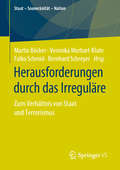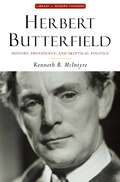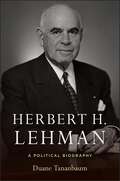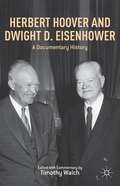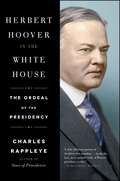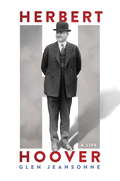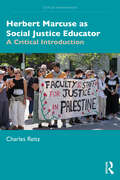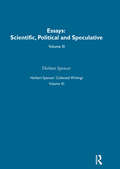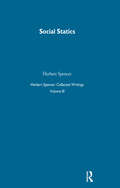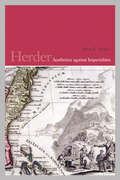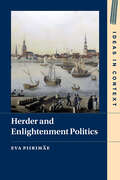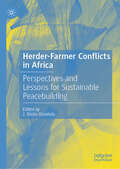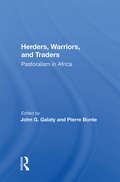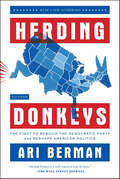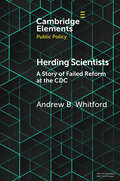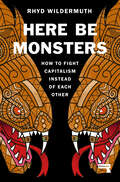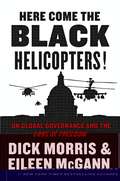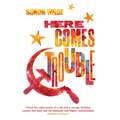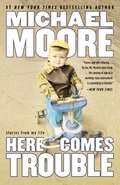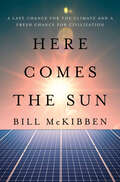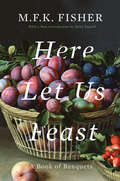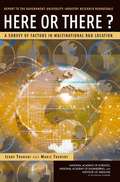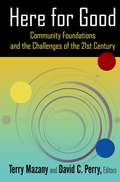- Table View
- List View
Herausforderungen durch das Irreguläre: Zum Verhältnis von Staat und Terrorismus (Staat – Souveränität – Nation)
by Martin Böcker Veronika Morhart-Klute Falko Schmid Bernhard SchreyerDieser Band analysiert Terrorismus als ein vielschichtiges Phänomen, das von unterschiedlichen wissenschaftlichen Disziplinen und politischen Institutionen untersucht und bekämpft werden muss. Der Staat steht dabei irregulären Kräften gegenüber, die an keine Normen gebunden sind. Sie können auf alle Mittel zurückgreifen, derer sie habhaft werden und sie in jeder Weise einsetzen. Es werden daher verschiedene Formen des Terrorismus und ihre Instrumente vorgestellt, die nicht nur in Gewaltanwendung bestehen. Neben einer rein wissenschaftlichen Betrachtung wird auch der praktische Umgang mit diesem Phänomen beleuchtet.Der InhaltTheoretische Überlegungen • Herausforderungen • Antworten und ReaktionenDie HerausgeberMartin Böcker ist Büroleiter und Verbindungsoffizier in der Beratergruppe der Deutschen Bundeswehr in Dakar, Senegal.Dipl. sc. pol. Falko Schmid arbeitet in der Branddirektion der Landeshauptstadt München, Abteilung Einsatzlenkung - Einsatzführungsdienst.Dr. med. Veronika Morhart-Klute ist Fachärztin für Psychiatrie und Psychotherapie, Suchtmedizin, Notfallmedizin, Geriatrie, Spez. Schmerztherapie.Dr. Bernhard Schreyer ist wissenschaftlicher Mitarbeiter in der Redaktion Staatslexikon an der Universität Passau.
Herbert Butterfield: History, Providence, and Skeptical Politics (Library of Modern Thinkers)
by Kenneth B. McIntyre"The most original historian of his generation." That is how the celebrated British academic Noel Annan described Herbert Butterfield (1900–1979), a profound and prolific writer who made important contributions as both a public and academic historian. In this authoritative and accessible intellectual biography, Kenneth B. McIntyre explores the extraordinary range of Butterfield's work. He shows why the small book The Whig Interpretation of History (1931) achieved such large influence; Butterfield, he demonstrates, has profoundly shaped American and European historiography by highlighting the distortions that occur when historians interpret the past merely as steps along the way toward the glorious present. But McIntyre delves much deeper, examining everything from Butterfield's lectures on history, historiography, and Christianity, to his warnings about the dangers of hubris in international affairs, to his essays on the origins of modern science, which basically created the modern discipline of the history of science. This latest volume in the acclaimed Library of Modern Thinkers series helps us understand a prescient and insightful thinker who challenged dominant currents in history, historiography, international relations, and politics.
Herbert C. Hoover: Thirty-first President Of The United States
by Barbara Garland Polikoff Richard G. YoungPresents the life of Herbert Hoover, including his childhood, education, employment, and political career.
Herbert H. Lehman: A Political Biography
by Duane TananbaumThis new biography of Herbert Lehman—the first in a half century—fills the void left by historians and political scientists who have neglected one of the truly great liberal icons of the mid-twentieth century. Based on extensive research in archival sources, Herbert H. Lehman restores this four-term Governor of New York, US Senator, national and international humanitarian, and political reformer to his rightful place among the pantheon of liberal heroes of his era. By focusing on Lehman's interactions with Al Smith, Franklin Roosevelt, Harry Truman, Lyndon Johnson, and John Kennedy, Duane Tananbaum shows how Lehman succeeded politically despite his refusal to compromise with his conscience. In his thirty-five years of public service, Herbert Lehman fought the Republicans in the State Legislature to provide economic security for New Yorkers during the Great Depression, and he battled the bureaucrats in the Roosevelt and Truman administrations and the United Nations Relief and Rehabilitation Administration to feed the starving people in Europe and Asia during and after World War II. His efforts on behalf of "the welfare state," civil rights legislation, and immigration reform helped keep the liberal agenda alive until Congress, and the nation, were ready to enact it into law as part of Lyndon Johnson's Great Society in 1964–1965.
Herbert Hoover and Dwight D. Eisenhower
by Timothy WalchBringing together core selections from and analysis of material documenting the uneasy collaboration between Herbert and Eisenhower, this collection incisively uses primary sources to illuminate the 1952 Republican nomination fight, the second Hoover Commission, and other key episodes during the Eisenhower presidency.
Herbert Hoover in the White House: The Ordeal of the Presidency
by Charles Rappleye"A deft, filled-out portrait of the thirty-first president...by far the best, most readable study of Hoover's presidency to date." --Publishers Weekly Rappleye's surprising portrait of a Depression-era president Herbert Hoover reveals a very different figure than the usual Hoover, engaged and active but loathe to experiment and conscious of his inability to convey hope to the country.Herbert Clark Hoover was the thirty-first President of the United States. He served one term, from 1929 to 1933. Often considered placid, passive, unsympathetic, and even paralyzed by national events, Hoover faced an uphill battle in the face of the Great Depression. Many historians dismiss him as merely ineffective. But in Herbert Hoover in the White House, Charles Rappleye draws on rare and intimate sources--memoirs and diaries and thousands of documents kept by members of his cabinet and close advisors--to reveal a very different figure than the one often portrayed. The real Hoover, argues Rappleye, just lacked the tools of leadership. The Hoover presented here will come as a surprise to both his longtime defenders and his many critics. In public Hoover was shy and retiring, but in private he is revealed as a man of passion and sometimes of fury, a man who intrigued against his enemies while fulminating over plots against him. Rappleye describes him as more sophisticated and more active in economic policy than is often acknowledged. We see Hoover watching a sunny (and he thought ignorant) FDR on the horizon. FDR did not "cure" the depression, but he experimented with steps that relieved it. Most importantly he broke the mood of doom almost immediately. The Hoover we see here--bright, well meaning, energetic--lacked the single critical element to succeed as president. He had a first-class mind and a second-class temperament. Herbert Hoover in the White House is an object lesson in the most, perhaps only, talent needed to be a successful president--the temperament of leadership.
Herbert Hoover: A Life
by Glen JeansonnePrizewinning historian Glen Jeansonne delves into the life of our most misunderstood president, offering up a surprising new portrait of Herbert Hoover—dismissing previous assumptions and revealing a political Progressive in the mold of Theodore Roosevelt, and the most resourceful American since Benjamin Franklin. <P><P> Orphaned at an early age and raised with strict Quaker values, Hoover earned his way through Stanford University. His hardworking ethic drove him to a successful career as an engineer and multinational businessman. After the Great War, he led a humanitarian effort that fed millions of Europeans left destitute, arguably saving more lives than any man in history. As commerce secretary under President Coolidge, Hoover helped modernize and galvanize American industry, and orchestrated the rehabilitation of the Mississippi Valley after the Great Flood of 1927. <P> As president, Herbert Hoover became the first chief executive to harness federal power to combat a crippling global recession. Though Hoover is often remembered as a “do-nothing” president, Jeansonne convincingly portrays a steadfast leader who challenged congress on an array of legislation that laid the groundwork for the New Deal. In addition, Hoover reformed America’s prisons, improved worker safety, and fought for better health and welfare for children. Unfairly attacked by Franklin D. Roosevelt and blamed for the Depression, Hoover was swept out of office in a landslide. Yet as FDR’s government grew into a bureaucratic behemoth, Hoover became the moral voice of the GOP and a champion of Republican principles—a legacy re-ignited by Ronald Reagan and which still endures today.<P> A compelling and rich examination of his character, accomplishments and failings, this is the magnificent biography of Herbert Hoover we have long waited for.
Herbert Marcuse as Social Justice Educator: A Critical Introduction (Critical Interventions)
by Charles ReitzDemonstrating the continued relevance of Marcuse’s work, Herbert Marcuse as Social Justice Educator details how his teachings remain a countervailing force to the conventional wisdom in intellectual and political matters today.By drawing on Marcuse’s critical analysis of the political economy, a profound concern for environmental issues, and an explicit critique of educational philosophy, this book illuminates not only the content and contours of Marcuse’s work but its importance for developing critical social scientific thinking and theoretical insight into contemporary issues such as genocide and ecocide, fascism and democratic crises, political economy and social inequality, and the role of culture and media in forming compliant consumer-citizens.From Charles Reitz, a prominent leader in Marcuse studies, this book will be an essential guide for instructors, students, and learners in sociology, social theory, political science, and environmental studies.
Herbert Spencer: Collected Writings
by Herbert SpencerHerbert Spencer (1820-1903) was regarded by the Victorians as the foremost philosopher of the age, the prophet of evolution at a time when the idea had gripped the popular imagination. Until recently Spencer's posthumous reputation rested almost excusively on his social and political thought, which has itself frequently been subject to serious misrepresentation. But historians of ideas now recognise that an acquaintance with Spencer's thought is essential for the proper understanding of many aspects of Victorian intellectual life, and the present selection is designed to answer this need. It provides a cross-section of Spencer's works from his more popular and approachable essays to a number of the volumes of the Synthetic Philosophy itself. Volume III.
Herbert Spencer: Or, The Conditions Essential To Human Happiness Specified, And The First Of Them Developed
by Herbert SpencerHerbert Spencer (1820-1903) was regarded by the Victorians as the foremost philosopher of the age, the prophet of evolution at a time when the idea had gripped the popular imagination. Until recently Spencer's posthumous reputation rested almost excusively on his social and political thought, which has itself frequently been subject to serious misrepresentation. But historians of ideas now recognise that an acquaintance with Spencer's thought is essential for the proper understanding of many aspects of Victorian intellectual life, and the present selection is designed to answer this need. It provides a cross-section of Spencer's works from his more popular and approachable essays to a number of the volumes of the Synthetic Philosophy itself. Volume III: Social Statics, Or the Conditions Essential to Human Happiness specified and then the fifst of them Developed.
Herder
by John K. NoyesAmong his generation of intellectuals, the eighteenth-century German philosopher Johann Gottfried Herder is recognized both for his innovative philosophy of language and history and for his passionate criticism of racism, colonialism, and imperialism. A student of Immanuel Kant, Herder challenged the idea that anyone - even the philosophers of the Enlightenment - could have a monopoly on truth.In Herder: Aesthetics against Imperialism, John K. Noyes plumbs the connections between Herder's anti-imperialism, often acknowledged but rarely explored in depth, and his epistemological investigations. Noyes argues that Herder's anti-rationalist epistemology, his rejection of universal conceptions of truth, knowledge, and justice, constitutes the first attempt to establish not just a moral but an epistemological foundation for anti-imperialism. Engaging with the work of postcolonial theorists such Dipesh Chakrabarty and Gayatri Spivak, this book is a valuable reassessment of Enlightenment anti-imperialism that demonstrates Herder's continuing relevance to postcolonial studies today.
Herder and Enlightenment Politics (Ideas in Context #147)
by Eva PiirimäeJohann Gottfried Herder initiated the modern disciplines of philosophical anthropology and cultural history, including the study of popular culture. He is also remembered as a sharp critic of colonialism and imperialism. But what types of social, economic and political arrangements did Herder envision for modern European societies? Herder and Enlightenment Politics provides a radically new interpretation of Herder's political thought, situating his ideas in Enlightenment debates on modern patriotism, commerce and peace. By reconstructing Herder's engagement with Rousseau, Montesquieu, Abbt, Ferguson, Möser, Kant and many other contemporary authors, Eva Piirimäe shows that Herder was deeply interested in the potential for cultural, moral and political reform in Russia, Germany and Europe. Herder probed the foundations of modern liberty, community and peace, developing a distinctive understanding of human self-determination, natural sociability and modern patriotism as well as advocating a vision of Europe as a commercially and culturally interconnected community of peoples.
Herder's Political Thought
by Vicki A. SpencerJohann Gottfried Herder was a philosopher and important intellectual presence in eighteenth-century Germany. Herder's Political Thought examines the work of this significant figure in the context of both historical and contemporary developments in political philosophy.Vicki A. Spencer reveals Herder as one of the first Western philosophers to grapple seriously with cultural diversity without abandoning a commitment to universal values and the first to make language and culture an issue of justice. As Spencer argues, both have made Herder a source of inspiration for the pluralist turn of contemporary political philosophy. Contending that in an era of globalization, it is no longer possible to ignore Herder's crucial insights on the relationship between cultural membership and individual identity, Spencer demonstrates how these ideas can help us understand, and perhaps resolve, the linguistic and cultural-political struggles of our times.
Herder-Farmer Conflicts in Africa: Perspectives and Lessons for Sustainable Peacebuilding
by J. Shola OmotolaThis book seeks to deepen empirical understandings of herder–farmer conflicts in Africa from the perspective of peacebuilding. Thus, the focus of the book is on the manifestations, causes, consequences and management of these conflicts (responses) by both state and non-state actors and lessons for sustainable peacebuilding. By adopting a comparative approach spanning five countries (Burkina Faso, Cameroon, Nigeria, Sudan and Togo), our study seeks not only to fill the gap, but also expand the frontier of knowledge on the subject, exploring important cross-cutting issues such as human rights, rule of law, gender and youth. The interconnections between these conflicts and security, safety and development at all levels underscore the urgency and pertinence of this study.
Herders, Warriors, And Traders: Pastoralism In Africa
by John G GalatyAfrican pastoralists have been devastated by drought, famine and dislocation, yet herding remains the most viable system of support for the inhabitants of the vast arid and semi-arid zones. Using case studies of the Tswana and the San, the interlacustrine pastoralists, the Masai and Mursi of East Africa, and the multi-ethnic regional systems of Lak
Herding Donkeys: The Fight to Rebuild the Democratic Party and Reshape American Politics
by Ari BermanAfter the 2004 election, the Republican Party held the White House, both houses of Congress, twenty-eight governorships, and a majority of state legislatures. One-party rule, it seemed, was here to stay. Herding Donkeys tells the improbable tale of the grassroots resurgence that transformed the Democratic Party from a lonely minority to a sizable majority. It chronicles the inside story of Howard Dean's visionary yet deeply controversial fifty-state strategy, charting his unpredictable journey from insurgent presidential candidate, to front-running flameout, to chairman and conscience of the Democratic Party in an unexpected third act. Ari Berman reveals how the Obama campaign built upon Dean's strategy when others ridiculed it, expanding the ranks of the party and ultimately laying the groundwork for Obama's historic electoral victory—but also sowing the seeds of dissent that would lead to legislative stalemate and intraparty strife.Revelatory and entertaining, in the vein of Timothy Crouse's The Boys on the Bus and Rick Perlstein's Nixonland, Herding Donkeys combines fresh reportage with a rich and colorful cast of characters. It captures the untold stories of the people and places that reshaped the electoral map, painting a vivid portrait of a shifting country while dissecting the possibility and peril of a new era in American politics.
Herding Scientists: A Story of Failed Reform at the CDC (Elements in Public Policy)
by Andrew B. WhitfordWhen politicians reshape public health agencies, scientists resist changes and, if possible, leave. Those shifts make it harder for agencies to fight future public health threats. This Element focuses on the tension between scientists and managerial control in the policy process, both conceptually and empirically. It centers on a failed attempt to reorganize the United States Centers for Disease Control and Prevention. Because many of the gains in longevity and health quality result from the work of public health agencies, public health scientists and practitioners are the frontline producers of public health.
Here Be Monsters: How to Fight Capitalism Instead of Each Other
by Rhyd WildermuthA clear and engaging history of how left radicalism went wrong and how it can become what it must be again.Here Be Monsters speaks to a left that has forgotten its history, its potential, and its power.Gramsci spoke of a time of monsters or morbid symptoms. In the ancient world, monsters were not enemies, but rather divine warnings, symptoms of a world out of balance. Here Be Monsters meets these monsters and listens to what they have to tell us.Interweaving personal stories with engaging histories of political thought and the meanings of monsters, Rhyd Wildermuth reveals the roots of current identity conflicts and political contradictions in feminism, anti-racist theory, Marxism, Frankfurt School theorists, and the many other leftist attempts to put the world back into balance.The left has always been the province of dreamers and visionaries, or as Ursula K. Le Guin named them, &“realists of a larger reality.&” Here Be Monsters is an urgent and deeply engaging narrative to help us remember that reality once more.
Here Come the Black Helicopters!
by Dick Morris Eileen McgannWhen it comes to spotting political abuses and covert conspiracies designed to strip Americans of their rights and freedoms, no one is more vigilant than #1 New York Times bestselling authors Dick Morris and Eileen McGann (Screwed!, Revolt!, Fleeced, Outrage). In their latest call-to-arms, Here Come the Black Helicopters!, Morris and McGann expose the most potent threat to date to our cherished way of life: the brazen and treacherous Liberal plan to circumvent our democratic processes by putting ultimate governing power in the hands of unaccountable international organizations. Filled with shocking, incontrovertible evidence as well as a concrete action plan, Here Come the Black Helicopters! is an essential read that will open the public's eyes to the catastrophe that will surely occur if we allow our misguided politicians to hand the reins of government over to a devious and frighteningly inept United Nations.
Here Comes Trouble: Shortlisted for the Bollinger Everyman Wodehouse Prize for Comic Fiction
by Simon WroeFollowing his expulsion from school, seventeen-year-old dreamer Ellis Dau is sent to work with his father. His father is editor of The Chronicle, the last bastion of free speech in their strange, strange land. And it is under threat: from heavy-handed policemen, mysterious revolutionaries, and the resident Russian billionaire. As Ellis navigates his collapsing, blacked-out city - and his feelings for the oligarch's beautiful daughter - he realises that some things are worth fighting for. But can he save his family and the newspaper fuelled only by youth, grain spirit and unrequited love?Read by Max Dowler(p) 2017 Orion Publishing Group
Here Comes Trouble: Stories from My Life
by Michael Moore"I had an unusually large-sized head, though this was not uncommon for a baby in the Midwest. The craniums in our part of the country were designed to leave a little extra room for the brain to grow in case one day we found ourselves exposed to something we didn't understand, like a foreign language, or a salad." Michael Moore--Oscar-winning filmmaker, bestselling author, the nation's unofficial provocateur laureate--is back, this time taking on an entirely new role, that of his own meta-Forest Gump. Breaking the autobiographical mode, he presents twenty-four far-ranging, irreverent, and stranger-than-fiction vignettes from his own early life. One moment he's an eleven-year-old boy lost in the Senate and found by Bobby Kennedy; and in the next, he's inside the Bitburg cemetery with a dazed and confused Ronald Reagan. Fast-forwarding to 2003, he stuns the world by uttering the words "We live in fictitious times ... with a fictitious president" in place of the expected "I'd like to thank the Academy." And none of that even comes close to the night the friendly priest at the seminary decides to show him how to perform his own exorcism. Capturing the zeitgeist of the past fifty years, yet deeply personal and unflinchingly honest, HERE COMES TROUBLE takes readers on an unforgettable, take-no-prisoners ride through the life and times of Michael Moore. No one will come away from this book without a sense of surprise about the Michael Moore most of us didn't know. Alternately funny, eye-opening, and moving, it's a book he has been writing-and living-his entire life. The guy who had an uncanny knack for just showing up where history was being made. You will be stunned and surprised to meet the Michael Moore you never knew. Capturing the zeitgeist of the past fifty years, yet deeply personal and unflinchingly honest, HERE COMES TROUBLE takes readers on an unforgettable, take-no-prisoners ride through the life and times of Michael Moore. Alternately funny, eye-opening, and moving, it's the book he has been writing--and living--his entire life.
Here Comes the Sun: A Last Chance for the Climate and a Fresh Chance for Civilization
by Bill McKibbenFrom the acclaimed environmentalist, a call to harness the power of the sun and rewrite our scientific, economic, and political future. Our climate, and our democracy, are melting down. But Bill McKibben, one of the first to sound the alarm about the climate crisis, insists the moment is also full of possibility. Energy from the sun and wind is suddenly the cheapest power on the planet and growing faster than any energy source in history—if we can keep accelerating the pace, we have a chance. Here Comes the Sun tells the story of the sudden spike in power from the sun and wind—and the desperate fight of the fossil fuel industry and their politicians to hold this new power at bay. From the everyday citizens who installed solar panels equal to a third of Pakistan’s electric grid in a year to the world’s sixth-largest economy—California—nearly halving its use of natural gas in the last two years, Bill McKibben traces the arrival of plentiful, inexpensive solar energy. And he shows how solar power is more than just a path out of the climate crisis: it is a chance to reorder the world on saner and more humane grounds. You can’t hoard solar energy or hold it in reserves—it’s available to all. There’s no guarantee we can make this change in time, but there is a hope—in McKibben’s eyes, our best hope for a new civilization: one that looks up to the sun, every day, as the star that fuels our world.
Here Let Us Feast: A Book of Banquets
by M. F. Fisher"M.F.K Fisher’s latest excursion into the art or science of gastronomy is more an anthology of the finest writing on the subject than strictly a text of her own composition . . . A royal feast, indeed!" —The New York TimesBetty Fussell—winner of the James Beard Foundation’s journalism award, and whose essays on food, travel, and the arts have appeared in The New York Times, The New Yorker, Saveur, and Vogue—is the perfect writer to introduce M.F.K Fisher’s Here Let Us Feast, first published in 1946. The author of Eat, Live, Love, Die has penned a brilliant introduction to this fabulous anthology of gastronomic writing, selected and with commentary from the inimitable M.F.K. Fisher.The celebrated author of such books as The Art of Eating, The Cooking of Provincial France, and With Bold Knife and Fork, Fisher knows how to prepare a feast of reading as no other. Excerpting descriptions of bountiful meals from classic works of British and American literature, Fisher weaves them into a profound discussion of feasting.She also traces gluttony through the Old and New Testaments of the Bible, and claims that the story of a nation's life is charted by its gastronomy. M.F.K. Fisher has arranged everything perfectly, and the result is a succession of unforgettable courses that will entice the most reluctant epicure.
Here Or There?: A Survey Of Factors In Multinational R&d Location
by National Academy Of Sciences National Academy of Engineering Institute of Medicine of the National AcademiesIn this report to the Government-University-Industry Research Roundtable, authors Jerry Thursby and Marie Thursby summarize their research on the globalization of corporate R&D. The authors surveyed 200 multinational companies about recent and future R&D location decisions, and the factors influencing those decisions. The survey confirms that China and India are primary targets of R&D expansion, but this trend does not yet portend a "hollowing out" of R&D capability in the United States. R&D location decisions are complex and driven by a variety of factors, including the potential for market growth, the quality of R&D personnel, and the environment for collaborating with universities. The cost of research, while important, is not the primary factor in siting decisions.
Here for Good: Community Foundations and the Challenges of the 21st Century
by Terry Mazany David C. PerryCommunity foundations bring together the resources of individuals, families, and businesses to support effective nonprofits in their communities. Over the years, foundations have come to engage community problem-solving through more than just grant-making. They have added a rich array of other activities, including programs of community capacity building, active modes of advocacy, and centres for meeting. In 2011, the 700+ institutions in the United States gave an estimated $4.2 billion to a variety of nonprofit activities in fields that included the arts and education, health and human services, the environment, and disaster relief.The origins of this book stem from conversations among the leadership of community foundations about the challenges they must overcome in order to make such "foundational" contributions to their communities. As community foundations enter the second century of their existence (the first foundation was formed in Cleveland in 1914), the need for knowledge and best practices has never been greater. This book, with expert authors representing the best and the brightest in this important field, fills that need.
